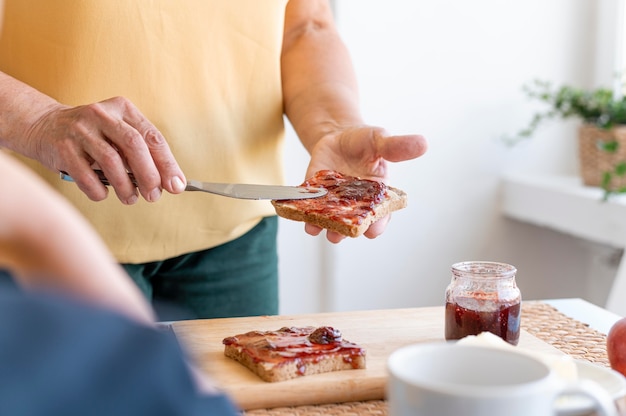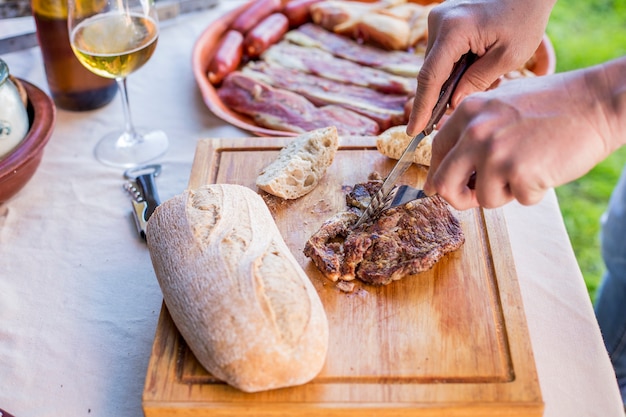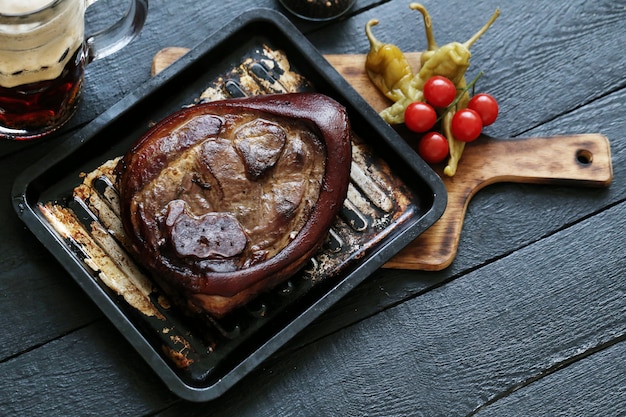You've got a beautiful pork tenderloin, ready to be transformed into a delicious meal. But the question looms: how long do you cook it for? I've been there – staring at that tenderloin, wondering if it's going to be dry or juicy. Don't worry, I'm here to share my experience and a few tips and tricks – so you can achieve perfect pork tenderloin every time.
(Part 1) Choosing Your Cooking Method: The Foundation of Success

The first step is to decide how you want to cook your pork tenderloin. Do you envision a sizzling pan-fry? A slow, gentle roast? Or maybe a blast of heat in the oven? Each method has its own personality, offering different flavor profiles and textures. Let's explore each option in more detail:
Pan-Frying: Quick, Easy, and Full of Flavor
Pan-frying is my go-to method for a quick and tasty pork tenderloin. It's perfect for weeknight meals when you want something delicious without spending ages in the kitchen. The high heat gives the tenderloin a lovely, crispy crust, while keeping the inside juicy and tender.
- Pro: Quick and easy, requiring minimal prep.
- Pro: Creates a delicious crispy crust that adds a satisfying texture contrast.
- Con: Can be tricky to get an even cook, especially for larger tenderloins.
- Con: Not ideal for large tenderloins, as they might not cook evenly.
Roasting: Slow and Steady for a Tender, Flavorful Result
For a more traditional approach, roasting is the way to go. It's a gentler method, allowing the tenderloin to cook evenly and retain moisture. You can even roast it with vegetables for a complete meal, letting the flavors mingle beautifully.
- Pro: Even cooking throughout, ensuring a consistently tender result.
- Pro: Versatile - can be roasted with vegetables or herbs, creating delicious flavor combinations.
- Con: Requires a longer cooking time, not ideal for last-minute meals.
- Con: Can be a little dry if not cooked properly, so careful monitoring is essential.
Oven-Baking: A Happy Medium of Speed and Flavor
Oven-baking offers a happy medium between pan-frying and roasting. It's quick and easy, with the added benefit of even cooking. You can even use a grill pan for a bit of crispy goodness on the bottom.
- Pro: Quick and easy, requiring minimal hands-on time.
- Pro: Even cooking, ensuring a consistent result throughout the tenderloin.
- Con: Not as flavorful as pan-frying, as it doesn't produce the same crispy crust.
- Con: Can be a little dry if not cooked properly, so careful monitoring is crucial.
(Part 2) pork tenderloin cooking time: The Essential Guide

Now that you've chosen your cooking method, let's get down to the nitty-gritty: cooking times. These are just general guidelines, as the actual time will vary depending on the size of your tenderloin and your oven's quirks. It's always a good idea to use a meat thermometer to ensure your pork is cooked to perfection.
Pork Tenderloin Cooking Times by Weight: A Quick Reference
Here's a general guide to cooking times for pork tenderloins of different weights, to give you a starting point:
| Tenderloin Weight (lb) | Pan-Frying Time | roasting time | Oven-Baking Time |
|---|---|---|---|
| 1 lb | 10-15 minutes | 25-30 minutes | 15-20 minutes |
| 1.5 lb | 15-20 minutes | 35-40 minutes | 20-25 minutes |
| 2 lb | 20-25 minutes | 45-50 minutes | 25-30 minutes |
internal temperature: The Key to juicy pork
The most important factor in determining doneness is the internal temperature of the pork tenderloin. The USDA recommends cooking pork to an internal temperature of 145°F (63°C). This ensures the pork is safe to eat while still being juicy and tender.
- For a juicy and tender pork tenderloin, aim for an internal temperature of 145°F (63°C). This is the magic number for perfect pork.
- Don't overcook it! overcooked pork will be dry and tough, a sad outcome for a beautiful tenderloin.
(Part 3) Mastering the Art of Pan-Frying: Sizzling Flavor and Crispy Perfection

Let's get our hands dirty and dive into the art of pan-frying. Pan-frying is a great way to cook a pork tenderloin quickly and easily. Here's my tried-and-true method:
1. Searing for Flavor: Creating a Crispy Crust
First, you want to get a good sear on your tenderloin. This will create a delicious crispy crust and lock in the juices, ensuring a tender and flavorful interior. Heat a cast-iron skillet or heavy-bottomed pan over medium-high heat. Add a tablespoon or two of your favorite oil, like olive oil or avocado oil. Once the oil is shimmering, carefully place the tenderloin in the pan. Let it cook for about 3-4 minutes per side, or until it’s nicely browned.
2. Even Cooking is Key: Gentle Heat for Tenderness
Once you've seared all sides, it's time to finish cooking the tenderloin. Reduce the heat to medium and continue cooking for another 5-7 minutes per side, or until the internal temperature reaches 145°F (63°C). Remember to use a meat thermometer to check the temperature. This ensures the tenderloin is cooked through without becoming dry.
3. Resting is Essential: Releasing the Juices
Once the tenderloin is cooked, remove it from the pan and let it rest for 5-10 minutes before slicing. This will allow the juices to redistribute and ensure a juicy and tender result. Resist the urge to cut into it immediately; patience pays off!
(Part 4) The Secrets to a Perfectly Roasted Tenderloin: Slow and Gentle for Maximum Flavor
Roasting a pork tenderloin is a classic way to prepare it. It's a slow and gentle cooking method that results in a beautifully tender and flavorful dish. Here's my tried-and-true method, perfected over time:
1. Seasoning for Success: Creating a Flavorful Foundation
Start by seasoning the tenderloin generously with salt, pepper, and any other spices you enjoy. I love to add a sprinkle of garlic powder, onion powder, or smoked paprika for extra flavor. Don't be shy with the spices; let them create a fragrant base for your tenderloin.
2. Roasting to Perfection: Even Heat for Even Cooking
Preheat your oven to 375°F (190°C). Place the tenderloin on a roasting rack in a baking pan. This will allow the heat to circulate evenly around the tenderloin, resulting in even cooking. Roast the tenderloin for 25-30 minutes per pound, or until the internal temperature reaches 145°F (63°C). Remember, the actual cooking time will vary depending on the size of your tenderloin and your oven.
3. Basting for Moisture: Maintaining Tenderness Throughout
To keep the tenderloin moist and flavorful, you can baste it during cooking. Basting involves spooning pan juices or melted butter over the tenderloin every 15-20 minutes. This will help to create a beautiful golden crust and prevent the tenderloin from drying out, ensuring a juicy and tender result.
(Part 5) Oven-Baking: A Quick and Easy Method for Busy Weeknights
Oven-baking is a simple and convenient way to cook a pork tenderloin. It's perfect for busy weeknights when you want a quick and easy meal. Here's how to do it:
1. Prepping the Tenderloin: Seasoning and Placement
Preheat your oven to 375°F (190°C). Season the tenderloin generously with salt, pepper, and any other spices you enjoy. Place the tenderloin on a baking sheet lined with parchment paper or foil. This will prevent the tenderloin from sticking to the pan and ensure easy cleanup.
2. Baking to Perfection: Monitoring for Even Cooking
Bake the tenderloin for 20-25 minutes per pound, or until the internal temperature reaches 145°F (63°C). Use a meat thermometer to check the temperature. You can also use a grill pan to create a nice crispy crust on the bottom for added texture.
3. Resting for Juiciness: Allowing the Juices to Redistribute
Once the tenderloin is cooked, remove it from the oven and let it rest for 5-10 minutes before slicing. This will allow the juices to redistribute and ensure a juicy and tender result. While you wait, prepare your sides and get ready to savor your delicious pork tenderloin.
(Part 6) Tips and Tricks for juicy pork tenderloin: Elevating Your Cooking Game
Now that you've got the basics down, here are a few tips and tricks to help you take your pork tenderloin game to the next level:
1. Don't Overcook It! The Key to Juicy, Tender Pork
Overcooked pork is dry and tough, a culinary tragedy. It's crucial to cook it to the correct internal temperature, which is 145°F (63°C). Use a meat thermometer to check the temperature and avoid overcooking. Remember, the goal is juicy and tender pork!
2. Brining for Extra Moisture: Unlocking Juiciness
Brining is a great way to add extra moisture and flavor to your pork tenderloin. To brine, simply soak the tenderloin in a salt water solution for several hours before cooking. This will help to keep the tenderloin juicy and tender, even if you overcook it slightly. You can also add herbs, spices, or sugar to the brine for added flavor.
3. Marinating for Flavor: Infusing Flavor and Tenderness
Marinating is another way to add flavor to your pork tenderloin. Simply soak the tenderloin in a marinade for several hours before cooking. Marinades can be made with a variety of ingredients, such as soy sauce, lemon juice, garlic, herbs, and spices. A good marinade will tenderize the meat and infuse it with flavor.
(Part 7) Serving Up Your Pork Tenderloin Masterpiece: Creating a Delicious Meal
Now that you've cooked a perfect pork tenderloin, it's time to serve it up! Here are some ideas to make your meal truly special:
1. Classic Sides: Complementary Flavors and Textures
Pork tenderloin pairs well with a variety of classic sides, such as:
- Roasted vegetables: Enhance the savory flavors of the pork tenderloin with roasted vegetables like carrots, broccoli, Brussels sprouts, or asparagus.
- mashed potatoes: creamy mashed potatoes provide a comforting contrast to the tender pork.
- rice pilaf: A flavorful rice pilaf adds a touch of elegance and compliments the savory pork.
- green beans: Fresh, crisp green beans add a refreshing element to the meal.
- Asparagus: Roasted or steamed asparagus brings a vibrant green touch and a delicate flavor to the plate.
2. Sauces and Glazes: Adding a Touch of Decadence
Add a touch of decadence with a delicious sauce or glaze. Here are a few ideas:
- Pan sauce: Deglaze the pan with wine or broth and whisk in butter and herbs for a simple but flavorful sauce. This captures the essence of the cooking process.
- Apple cider glaze: Combine apple cider, brown sugar, and cinnamon for a sweet and savory glaze that balances the pork's savory notes.
- honey mustard glaze: Whisk together honey, Dijon mustard, and a touch of garlic for a tangy and sweet glaze that adds a touch of zest.
3. Presentation Matters: Creating a Visually Appealing Dish
Even the simplest dish can be made more appealing with a little presentation. Slice the tenderloin into thick medallions and arrange them on a platter. Garnish with fresh herbs, roasted vegetables, or a drizzle of sauce for a visually stunning and delicious meal.
(Part 8) FAQs: Pork Tenderloin Cooking Time Demystified
Got any questions about cooking a pork tenderloin? Don't worry, I've got you covered. Here are some answers to frequently asked questions:
1. What if I overcook the pork tenderloin?
If you overcook the pork tenderloin, it will be dry and tough. There's not much you can do to fix it, but you can try to add some moisture back by adding a sauce or glaze. It's always best to err on the side of undercooking slightly and using a meat thermometer to ensure doneness.
2. Can I cook a frozen pork tenderloin?
It's not recommended to cook a frozen pork tenderloin. Frozen pork takes longer to cook and can result in uneven cooking. It's best to thaw the pork tenderloin completely in the refrigerator before cooking. This ensures even cooking and a juicy result.
3. How do I know when the pork tenderloin is cooked through?
The best way to know when the pork tenderloin is cooked through is to use a meat thermometer. The USDA recommends cooking pork to an internal temperature of 145°F (63°C). This is the most reliable way to ensure safe and delicious pork.
4. What's the best way to store leftover pork tenderloin?
Leftover pork tenderloin can be stored in an airtight container in the refrigerator for up to 3-4 days. You can also freeze leftover pork tenderloin for up to 2-3 months. To freeze, wrap the tenderloin tightly in plastic wrap and then aluminum foil. This helps prevent freezer burn and preserves the quality of the pork.
5. Can I cook a pork tenderloin in a slow cooker?
Yes, you can cook a pork tenderloin in a slow cooker. Simply place the tenderloin in the slow cooker, add your favorite seasonings and sauce, and cook on low for 6-8 hours or on high for 3-4 hours. The pork will be incredibly tender and flavorful. This is a great method for a hands-off approach to cooking a delicious pork tenderloin.
(Part 9) Conclusion: Your Pork Tenderloin Journey Begins Now
There you have it, my friends – the ultimate guide to cooking a perfect pork tenderloin. Now you have the knowledge and confidence to cook this delicious and versatile dish. So get out there, experiment, and find your own favorite methods and techniques. And remember, practice makes perfect! With a little effort, you'll be serving up juicy, flavorful pork tenderloin that everyone will love. Happy cooking!
Everyone is watching

Corn on the Cob: The Ultimate Guide to Perfectly Cooked Ears
Healthy MealsAh, corn on the cob. Just the name evokes images of sunny days, barbecues, and that sweet, juicy flavour that ...

Perfect Pork Roast Oven Cooking Time: A Guide to Delicious Results
Healthy MealsThere's something truly satisfying about a perfectly roasted pork. The aroma alone is enough to make your mout...

Ham Cooking Time: How Long to Bake, Smoke, or Boil a Delicious Ham
Healthy MealsAh, ham. It's a classic, isn't it? A real crowd-pleaser, especially around holidays. And when done right, it'...

Scallops: The Ultimate Guide to Perfect Cooking
Healthy MealsAh, scallops. Those delicate, sweet, and utterly delicious morsels of the sea. They hold a special place in my...

Spaghetti Squash: The Ultimate Guide to Cooking and Serving
Healthy MealsRemember that time you saw spaghetti squash at the supermarket, looking all bumpy and strange, and thought, "W...
